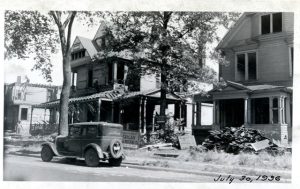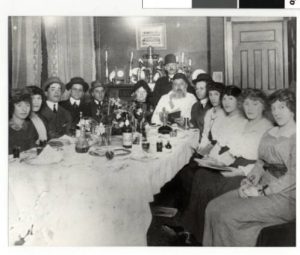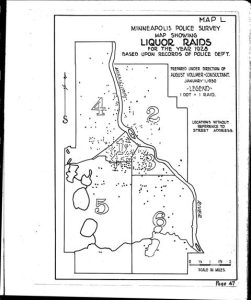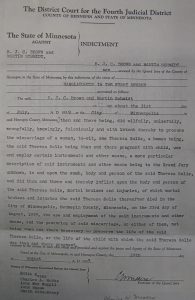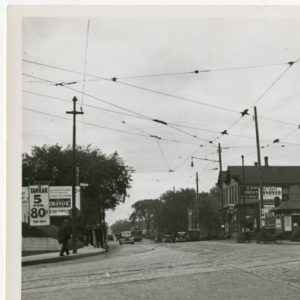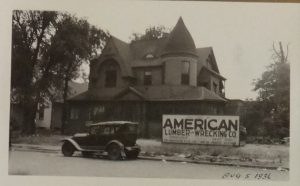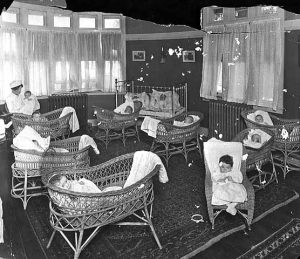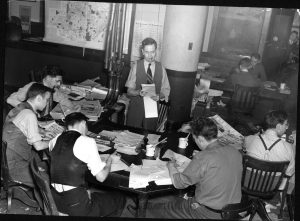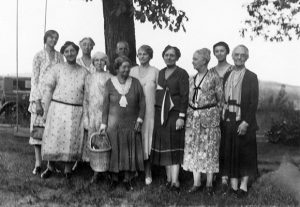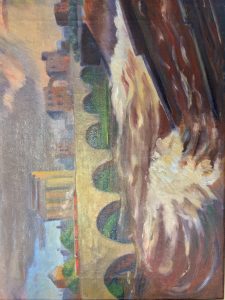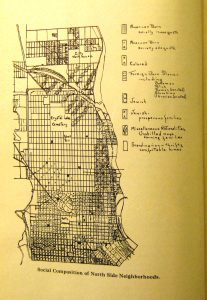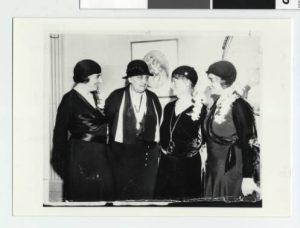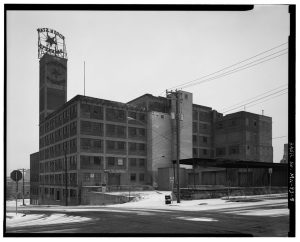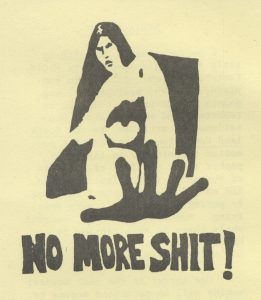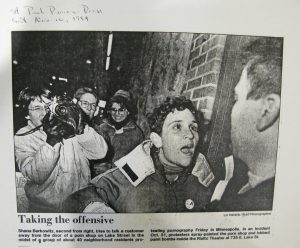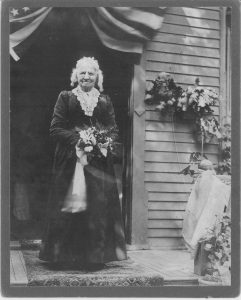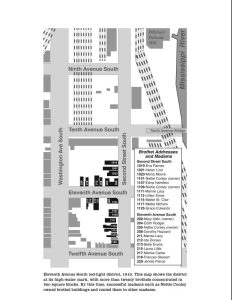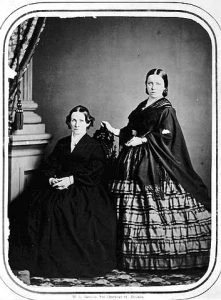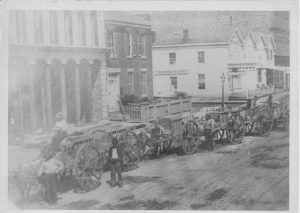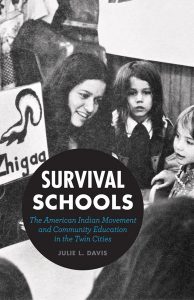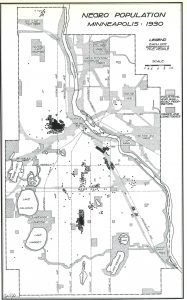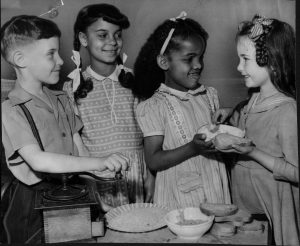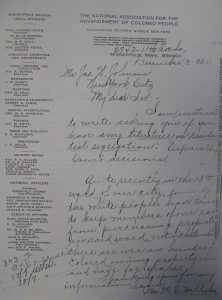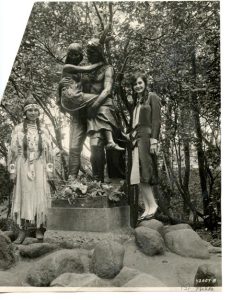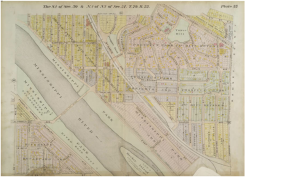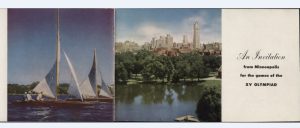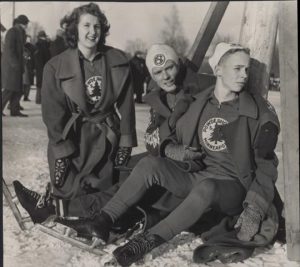Stories
The twilight moments of Oak Lake Park
Published April 16, 2014 by Kirsten Delegard Team Historyapolis spent yesterday in the tower archives at City Hall, unearthing more treasures that we’ll share in the weeks to come. Citizen-researcher Rita Yeada was occupied with the task of digitizing a battered scrapbook of photos we found on our last visit. This fragile volume contains black…
Read MoreHappy Passover
Published April 16, 2014 by Kirsten Delegard Happy Passover! This Jewish holiday is traditionally celebrated with a seder. During this ceremonial meal, participants recount the story of how Jews were delivered from slavery thousands of years ago. This 1915 photo shows a seder in the Minneapolis home of Rabbi Silber, who led Congregation Kenesseth Israel…
Read More“The sale of alcoholic beverages never really stopped in the Gateway . . .It probably never even paused”
Published April 14, 2014 by Kirsten Delegard It’s map Monday. This diagram shows liquor raids in Minneapolis during 1928. The data for this info-graphic was collected at the height of Prohibition, eight years after the Volstead Amendment banned the sale and consumption of liquor in the United States. This map was published as part of…
Read More“An Illegal Operation”: The Case of Theresa Solie, part 2
Published April 24, 2014 by Derek Waller Today’s guest blogger is Derek Waller, a senior from St. Olaf College who interned with the Historyapolis Project for his January term. A history major with a minor in gender studies, Waller explores the history of abortion in Minneapolis in this two-part post. Shortly after Theresa Solie died…
Read More“An Illegal Operation”: The Case of Theresa Solie
Published April 24, 2014 by Derek Waller Today’s guest blogger is Derek Waller, a senior from St. Olaf College who interned with the Historyapolis Project for his January term. A history major with a minor in gender studies, Waller explores the history of abortion in Minneapolis in this two-part post. When Theresa Solie arrived in…
Read MoreLake Calhoun Expressway
Published April 9, 2014 by Kirsten Delegard More dispatches from the Minneapolis City Archives. This watercolor from 1938 shows a proposal to elevate Lake Street as it runs along Lake Calhoun in front of the Calhoun Beach Club. If this plan had been realized, the intersection of Lake Street and Excelsior Boulevard would have become…
Read MoreImages from Oak Lake Park
Published April 8, 2014 by Kirsten Delegard Yesterday I wrote about the lost neighborhood of Oak Lake Park and the unexplored terrain of the Minneapolis City Archives. In my first foray into the city’s attic, as I have come to think of it, I discovered a thick scrapbook of photos collection by an employee in…
Read MoreLost neighborhoods and forgotten archives
Published April 7, 2014 by Kirsten Delegard It’s map Monday. Today we have a map from the Minneapolis City Archives, a little known repository of our community history. This map shows plans to destroy Oak Lake Park, an upscale Victorian neighborhood that had its glory years when Minneapolis was in its infancy. Today there is…
Read More“The Duty of Not Keeping Silent”: Martha Ripley and Minneapolis Maternity Hospital
Published April 24, 2014 by Jacqueline deVries Guest blogger today is Jacqueline deVries, Professor of History and Women’s Studies at Augsburg College. deVries is writing a book on women’s health care in Britain and its empire. To modern eyes, there is nothing revolutionary about this sweet image of babies in nursery baskets. But these babies…
Read MoreThe Old Copy Desk of the Star and Tribune
Published April 3, 2014 by Kirsten Delegard News that local businessman Glen Taylor would like to buy the Star Tribune has many Minnesotans breathing easier. Taylor has declared that he believes the newspaper to be an important community institution. And he thinks that local ownership is important to ensuring that the newspaper make the decisions…
Read MoreWorking from the Margins: Eloise Butler and Her Wildflower Garden
Published April 2, 2014 by Sara Strozok Guest blogger today is Sara Strzok, a medical writer and editor based in Minneapolis. Like so many women of her era, Eloise Butler (1851-1933) worked on the margins – in her case, both socially and geographically – to get what she wanted. In 1907, she joined the ranks…
Read MoreThe hidden geography of feminism
Published March 31, 2014 by Kevin Ehrman-Solberg It’s Map Monday. Today we have a custom map created by Kevin Ehrman-Solberg, a senior history major at Augsburg and one of the student interns at the Historyapolis Project for 2014. Since the eighteenth century, feminism has inspired women to re-imagine personal relationships, institutional structures and public spaces.…
Read MoreWant proof that Minnesota is cosmopolitan? “Ford or ankle out to the Minneapolis Art Institute”
Published March 27, 2014 by Bill Wittenbreer Today’s guest blogger is Bill Wittenbreer, a founding member of the Historyapolis Lab at Augsburg College. In 2002-3, Bill co-curated an exhibition at Minnesota Museum of American Art called An Artist’s Paradise: Minnesota Landscape Painters 1840-1940. Here he profiles Martha Washburn Allin, a painter and watercolorist who made art…
Read MoreMyrtle A. Cain: “indorsed by the Working People’s Political League”
Published March 25, 2014 by Anna Romskog Today’s blogger is Anna Romskog is a junior history major at Augsburg College. She will be a regular presence here during 2014, when she will be working as one of the student researchers for the Historyapolis Project. This card–from 1922–urges voters in the 28th district of Minneapolis to…
Read More“The mixture of races in this district is detrimental”
Published March 24, 2014 by Kirsten Delegard It’s map Monday. This “Social Composition of North Side Neighborhoods” was drawn by a researcher associated with the Women’s Cooperative Alliance, which assembled an encyclopedic analysis of moral conditions in the city in 1925. The Cooperative Alliance was a consortium of women’s groups organized in April, 1917 to…
Read More“We must not seek to modify war, but to outlaw it”
Published March 21, 2014 by Ann Lonstein Guest blogger today is Ann Lonstein, a writer and researcher who was president of the Minneapolis Section of the National Council of Jewish Women between 1987 and 1990. “I have faith that women will some day make a great contribution to civilization,” Fannie Fligelman Brin wrote to a…
Read More“When a girl’s got her living to earn she can’t choose where she’ll work”
Published March 20, 2014 by Tamatha Perlman Today’s guest blogger is Tamatha Perlman, a writer and museum professional, who is working on a book about murder, madness and unrequited love in 19th century Minneapolis. In this post she describes the working conditions of women in the Mill City, using the work of labor journalist Eva…
Read More“We are working for the destruction of patriarchy”
Published March 19, 2014 by Stewart Van Cleve Guest blogger today is Stewart Van Cleve, a graduate student in the program for Library and Information Science at St. Catherine University and the author of Land of 10,000 Loves: A History of Queer Minnesota. In this post, Stewart writes about Minnesota’s first statewide lesbian organization: the…
Read More“Pornography is the theory and rape is the practice”
Published March 18, 2014 by Kevin Ehrman-Solberg Today’s blogger is Kevin Ehrman-Solberg, a senior history major at Augsburg and one of the student interns at the Historyapolis Project for 2014. Kevin will be a regular presence on this blog. Today he shares some of the research he has been doing for his senior thesis, which…
Read MoreLost to History: the South Minneapolis Pornography District of the 1980s
Published March 17, 2014 by Kevin Ehrman-Solberg It’s Map Monday. Today we have a custom map created by Historyapolis student researcher Kevin Ehrman-Solberg. It shows the geography of pornography in the 1970s and 1980s, when Minneapolis saw an explosion of the commercial sex industry. On this map, the red pins are are for theaters,…
Read MoreAmazon Feminist Bookstore
Published March 14, 2014 by Stewart Van Cleve Guest blogger today is Stewart Van Cleve, a graduate student in the program for Library and Information Science at St. Catherine University and the author of Land of 10,000 Loves: A History of Queer Minnesota. In this post, Stewart writes about Amazon Bookstore, the first feminist bookstore…
Read MoreThe woman who faced a white mob: Lena Olive Smith
Published March 13, 2014 by JaneAnne Murray Today’s guest blogger is JaneAnne Murray, a Minneapolis-based solo criminal defense lawyer and Practitioner in Residence at the University of Minnesota Law School, where she teaches classes in criminal law and procedure. In this post she describes the life and legacy of Lena Olive Smith, an African American…
Read MoreThe Civil Rights Movement from a Woman’s Perspective
Published March 12, 2014 by Kirsten Delegard This Wednesday in March provides a great moment to revisit this oral history of Josie Johnson and Maxine Nathanson, Minneapolis civil rights activists interviewed by TPT producer Daniel Bergin in 2003. Both members of the NAACP in Minneapolis, the women came together in their efforts to support the…
Read More“Where are the men who make these girls what they are?”
Published March 11, 2014 by Tamatha Perlman Today’s guest blogger is Tamatha Perlman, a writer and museum professional, who is working on a book about murder, madness and unrequited love in 19th century Minneapolis. In this post she describes one of the city’s most colorful founding mothers, the indomitable Charlotte Van Cleve, who established the Sisterhood of Bethany…
Read MoreMattie St. Clair and the Riverfront Red-Light District, 1910
Published March 10, 2014 by Kirsten Delegard It’s map Monday. This map shows the Minneapolis brothel district in 1910, as described by Penny Petersen in her book, Minneapolis Madams. Penny–who works as a researcher for a Minneapolis-based historical consultant–is our guest blogger today, with a post that remembers the notorious madam known as Mattie St.…
Read MoreHoop Skirts and Winter
Published March 7, 2014 by Kirsten Delegard Nineteenth century women’s fashions were rather impractical for life in Minnesota. In 1914, a woman who had arrived as a young girl in Minneapolis in 1856–two years before Minnesota became a state–remembers the challenges of winter when you had to wear a hoop skirt, like the two women…
Read More“Those carts would go squawking by all day”
Published March 6, 2014 by Kirsten Delegard In the years before Minnesota became a state, many women moved to the settlement that became Minneapolis with the idea that they were joining a New England village with a particularly invigorating climate. New England was regarded as the cradle of American civilization for many early inhabitants, who…
Read MoreMarch is Maple Sugar Month
Published March 5, 2014 by Kirsten Delegard The month we now devote to women’s history was traditionally dedicated to maple sugaring for Dakota and Ojibwe women. The beginning of meteorological spring sent Indian men in search of muskrat pelts. They separated from their women and children, who moved their camps into the sugar bush. These…
Read MoreWomen’s History Month on Historyapolis
Published March 4, 2014 by Kirsten Delegard March is women’s history month. Historyapolis is going to suspend regular programming to focus exclusively on women and gender for the entire month. And I’m going to be stepping back from the keyboard and inviting other writers to share stories, biographies and analysis that can illuminate life in…
Read MoreNeighborhood activism and the origins of residential segregation in Minneapolis
Published March 3, 2014 by Kirsten Delegard It’s map Monday. Here we have another map from Calvin Schmid’s Social Saga of Two Cities, the demographic opus he published in 1937 with the support of the Minneapolis Council of Social Agencies. This chart shows the concentration of “Negro Population” in Minneapolis, circa 1930. Over the last…
Read MoreThe bread and butter of civil rights
Published February 27, 2014 by Kirsten Delegard In May, 1946, first graders at William Penn school hosted a party. The students at the elementary school–located at 36th and Penn Avenue North– served bread they had baked themselves, which they spread with butter and peanut butter for their guests. The hosts–who were white–were welcoming children into…
Read More“They know they are undesirable as neighbors”
Published February 26, 2014 by Kirsten Delegard On December 3, 1920, the Secretary of the Minneapolis branch of the National Association for the Advancement of Colored People penned a letter to her organization’s headquarters in New York City. She was writing to request any literature available on “residential segregation. Especially court decisions.” Two weeks earlier,…
Read MoreMinneapolis and the Cult of Hiawatha
Published February 26, 2014 by Kirsten Delegard I found this photo in the newspaper morgue in the Minneapolis collection at the Hennepin County Central library. Dated October 6, 1927, it shows two girls–one dressed like a fictional “Indian maiden”–posing by Jakob Fjelde’s Hiawatha and Minnehaha statue at Minnehaha Park. It’s impossible to know the reason…
Read MoreRace War continued: Linden Hills, 1909
Published February 25, 2014 by Kirsten Delegard Prospect Park was not the only Minneapolis neighborhood to experience racial turmoil in 1909. Linden Hills erupted in protest when one resident decided to retaliate against her neighbors by selling her home to an African-American newcomer to the city. When Marie Canfield announced that Methodist Reverend William S.…
Read MoreMinneapolis “Race War” 1909: Prospect Park
Published February 24, 2014 by Kirsten Delegard It’s map Monday. This plate–from the 1914 real estate atlas for Minneapolis–shows the Prospect Park neighborhood near the Mississippi River. This orderly grid gives no hint of the emotions stirred in this section of the city in 1909, when an African American family purchased three lots at 17…
Read MoreOlympic-style icy thrills
Published February 18, 2014 by Kirsten Delegard Like many of you, I’ve been watching footage from the Olympic sliding center in Sochi, where bobsled, luge and skeleton athletes rocket down the icy track at 80 miles per hour. Before World War I, it seems that Minneapolis had its own sliding centers that delivered thrills and…
Read MoreThe President Streets
Published February 17, 2014 by Kirsten Delegard It’s map Monday. And of course, it’s also President’s Day. So here we have a detail from an 1885 map of Northeast Minneapolis that focuses on the President Streets. Most Minneapolitans know this neighborhood in Nordeast, where you can learn your presidents–and the order in which they were…
Read More“The Olympic winter sports games will be held in Minneapolis in 1928 or 1932”
Published February 14, 2014 by Kirsten Delegard In 1924, Glenwood Park in Minneapolis hosted the trials for the U.S. Olympic ski team. The success of this event prompted Minneapolis Park Superintendent Theodore Wirth to make a prediction in his report for that year. “The prospects are that the Olympic winter sports games will be held…
Read MoreFreeways and Speedskating
Published February 13, 2014 by Kirsten Delegard When speedskater Johnny Werket returned to Minneapolis after placing sixth in Olympic competition at St. Moritz, his classmates at Augsburg College suspended normal routine to celebrate his accomplishments. The campus welcomed him home with a marching band, assembly and dinner. March, 15, 1948 was declared “Johnny Werket Day.”…
Read More“You either skated or did nothing”
Published February 11, 2014 by Kirsten Delegard Today Minnesota sends Nordic skiers and hockey players to the winter Olympics. Sixty years ago, Minneapolis produced many of the world’s top competitors in speedskating. “Skating was the natural thing for a boy to do then,” explained Ken Bartholomew, who won 14 national championships and an Olympic silver…
Read More